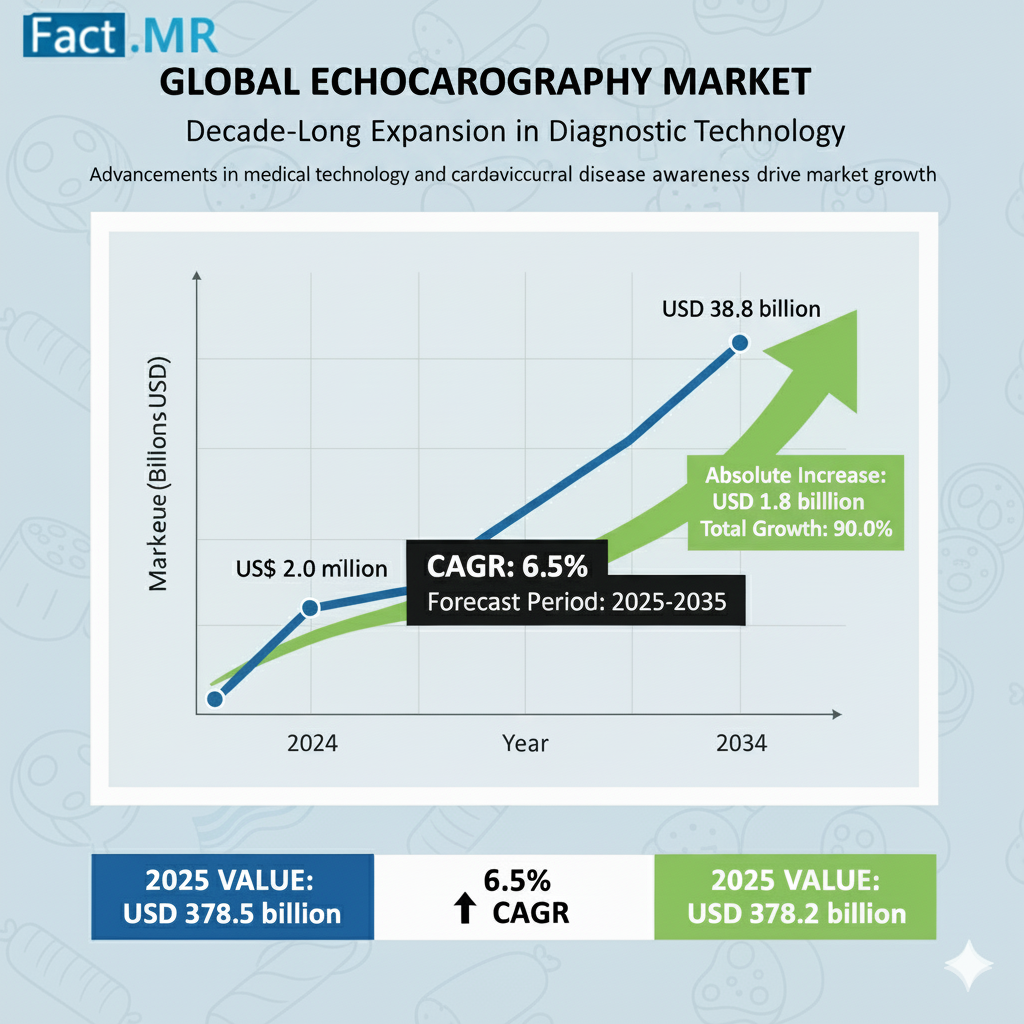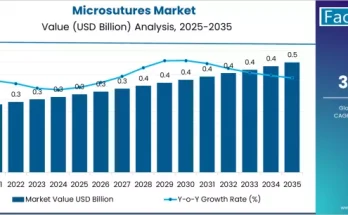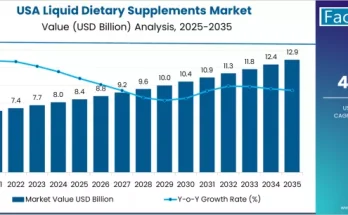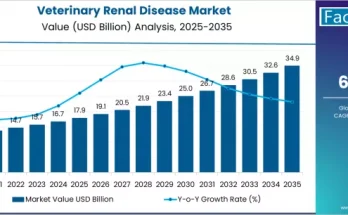Echocardiography market size is approximated at a value of US$ 2 billion in 2024. As per the detailed industry analysis by Fact.MR, worldwide sales of echocardiography solutions and systems are calculated to increase at a CAGR of 6.5% and reach US$ 3.8 billion by 2034.the industry is being reshaped by digital healthcare innovation, the rising burden of cardiovascular diseases, and rapid technological integration such as artificial intelligence (AI) and machine learning (ML) in imaging systems.
This data-backed growth outlook signals a prime opportunity for global manufacturers and healthcare technology providers to capture expanding demand for non-invasive, mobile, and intelligent echocardiography devices, as healthcare systems across regions pivot toward faster, patient-centric cardiac care.
Technological Integration: The Core Growth Catalyst:
The surge in AI-driven echocardiography solutions is revolutionizing cardiac imaging, enabling automated image capture, faster diagnostic interpretations, and real-time disease monitoring. Companies such as GE Healthcare, Philips Healthcare, Canon Medical Systems, and Siemens Healthineers AG are aggressively advancing AI-enabled platforms that support automatic labeling, grading, and cardiac function analysis.
One notable innovation comes from EchoNous, whose Kosmos System merges AI with point-of-care ultrasound (POCUS) to empower clinicians with on-the-spot, high-quality cardiac imaging. Similarly, strategic collaborations between hardware manufacturers and AI software developers are leading to the creation of smart echocardiography applications that can compute ejection fractions within seconds.
Fact.MR’s analysis suggests that AI and digital integration will remain the key differentiators for next-generation echocardiography devices, as healthcare facilities demand greater speed, precision, and remote operability in cardiac diagnostics.
Market Overview: Mobility and Miniaturization Take the Lead:
The global trend toward portable and handheld echocardiography devices is reshaping the competitive landscape. While cart- and trolley-based systems currently hold the largest market share, portable systems are gaining strong traction, particularly across rural and resource-constrained healthcare environments. The rising need for telemedicine, combined with the ability to perform bedside imaging and emergency cardiac evaluations, is expanding their adoption worldwide.
– Transthoracic echocardiogram machines account for a market value of USD 800 million in 2024 and are projected to reach USD 1.5 billion by 2034, registering a 6.3% CAGR. Their non-invasive and real-time imaging capabilities have made them a diagnostic mainstay in hospitals and diagnostic centers.
– 3D/4D echocardiography devices are projected to expand at a 6.8% CAGR, doubling from USD 700 million in 2024 to USD 1.4 billion by 2034, driven by their ability to provide live visualization of heart chambers, aiding in precise surgical planning and monitoring complex arrhythmias.
Regional Insights: North America Leads, East Asia Accelerates:
The North American echocardiography market remains a powerhouse, estimated at USD 500 million in 2024, with the United States alone contributing USD 200 million. The U.S. market is projected to grow at a 6.9% CAGR through 2034, fueled by high cardiovascular disease prevalence and substantial healthcare investments. According to the CDC, one person in the U.S. dies every 33 seconds from heart disease, underscoring the urgency for enhanced cardiac monitoring infrastructure.
Meanwhile, East Asia is emerging as a pivotal growth region, poised to capture 23.1% of the global market share by 2034. Japan, with its rapidly aging population and strong innovation ecosystem, is expected to witness a 7% CAGR, reaching USD 196.7 million by 2034. The adoption of wireless and home-based ECG monitoring systems is particularly accelerating in Japan, aligning with national initiatives for remote patient care and smart healthcare.
Innovation Frontiers: R&D and Start-Up Momentum:
The industry’s innovation ecosystem is expanding rapidly, led by both established players and promising start-ups.
– Biosense (U.S.) is developing non-contact ECG sensors that work through multiple layers of fabric, enhancing patient comfort and diagnostic accuracy.
– Neuraura (Canada) is pioneering wireless wearable EEG/ECG devices that integrate advanced visualization software for faster diagnosis and real-time cardiac monitoring.
In parallel, leading medical technology giants are investing heavily in acoustic quantification, pulse Doppler enhancements, and esophageal probe technologies to improve imaging clarity and diagnostic precision. The result is a convergence of hardware excellence and intelligent software ecosystems that are making echocardiography faster, smarter, and more accessible than ever before.
Challenges: Cost Barriers and Access Disparities:
Despite robust growth potential, high equipment costs continue to pose challenges for market penetration, particularly across developing economies and budget-constrained healthcare settings. Echocardiography machines are more expensive than traditional ultrasound systems, often restricting their use in smaller clinics and regional hospitals.
However, the ongoing miniaturization of components, coupled with increasing competition among global manufacturers, is expected to drive down costs over the long term, thereby expanding accessibility across diverse healthcare segments.
Competitive Landscape: Partnerships and Product Innovation Define Strategy:
The echocardiography market is witnessing a wave of strategic partnerships, R&D expansions, and M&A activities aimed at enhancing product portfolios and digital capabilities.
– In June 2022, Clarius Mobile Health partnered with ImaCor Inc. to commercialize the world’s first handheld transesophageal echocardiography (TEE) system, which has received FDA clearance for use in critical care settings.
– In 2018, Koninklijke Philips N.V. launched the EPIQ CVx cardiac ultrasound solution, integrating anatomical intelligence to improve surgical imaging and diagnostic precision.
Such developments highlight how industry leaders are prioritizing innovation-driven collaborations and AI-backed diagnostic solutions to maintain competitiveness and expand their footprint in a rapidly evolving healthcare ecosystem.
Outlook: Toward a Smarter, Connected Future:
Fact.MR forecasts a decade of strong, technology-led expansion for the echocardiography market. The growing convergence of AI, IoT, robotics, and big data analytics will redefine cardiac imaging workflows—making them more automated, mobile, and predictive. As digital healthcare infrastructure strengthens globally, the demand for real-time, non-invasive, and portable echocardiography devices will soar.
For industry leaders and medical device manufacturers, the message is clear: invest in innovation, prioritize affordability, and embrace digital transformation to capture the next phase of growth in this life-saving diagnostic domain.
Browse Full Report-https://www.factmr.com/report/echocardiography-market



